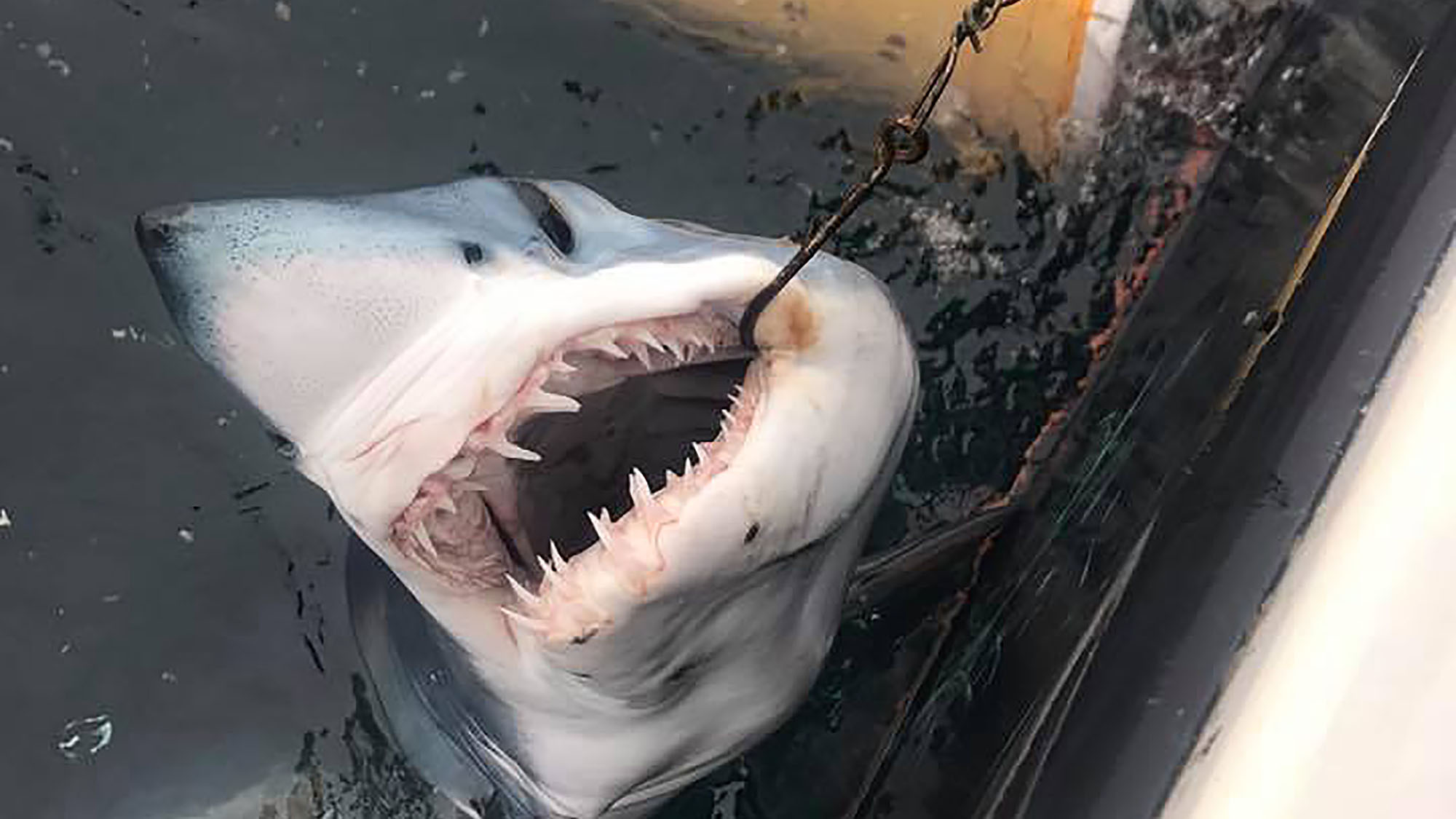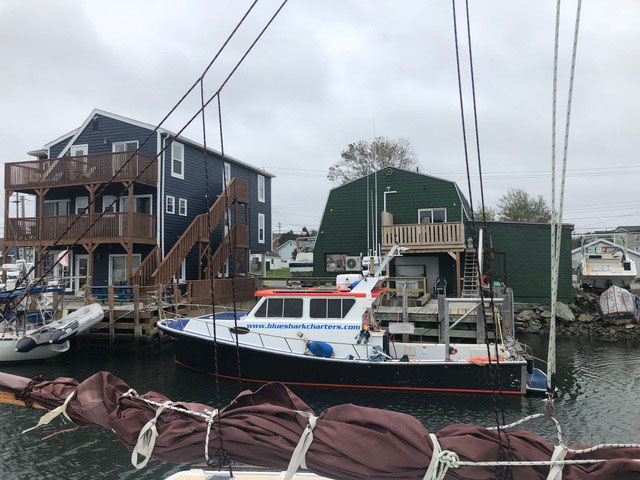Captain advocates for shark safety amid questionable Ocearch tagging methods
Art Gaetan takes issue with Ocearch’s shark tagging methods during their 2019 Nova Scotia expedition

caption
A blue shark is seen at the side of Gaetan's boat.Cue the Jaws music — now shut it off.
The sensationalized shark from pop culture, one that’s blood thirsty and always attacking beach-goers, isn’t reality, says Blue Shark Fishing Charters’ Capt. Art Gaetan.
Gaetan’s been studying Blue sharks for 55 years and operating his Eastern Passage-based charter for 20 years. He combines big game fishing with education and has found, despite a strong interest in sharks, knowledge about them and the ocean is limited.
“A lot of people have never seen a shark in the wild … But, to actually watch an animal in its natural habitat coming up alongside the side of the boat, and then, being able to lean over the side of it and pet it and hand-feed it. Usually, the comments you get from them is ‘I had no idea’ because everybody thinks these are monsters and they’re definitely not monsters at all,” says Gaetan.
Gaetan stresses the importance of safety for both sharks and humans above all.
This is a concern he and others feel isn’t shared by the organization Ocearch. As part of their research, Ocearch conducts expeditions where they tag sharks for research and study.
“Ocearch has been a master of public communications. It’s absolutely, positively penetrated the psyche of almost everybody anywhere they’ve gone,” says Frederick Whoriskey, executive director of the Ocean Tracking Network at Dalhousie University. “From that perspective, it’s a good thing … the concerns have really revolved around some of the practices.”
Ocearch teaches the public about sharks through their social media channels and online tracking platform. People can watch the sharks as they journey through the ocean and follow them on Twitter, as the sharks have their own Twitter personalities.

caption
Art Gaetan holds a blue shark on his fishing vesselGaetan’s teaching is hands-on. He brings the shark on board to teach passengers about it. He points to where their ears are and talks about their teeth and skin. People leave with a different, meaningful understanding of the shark.
Ocearch’s methods are much different, he says.
“Their attitude is that we can do what we want, where we want when we want, and you’re not going to stop us. And you know what they’re right,” says Gaetan. He observed them 1.2 miles from the shore. He says when he goes out, he must be three miles from the shore.
Gaetan says he’s observed Ocearch dragging a shark they caught for an hour before bringing it onboard. One of Ocearch’s claims is when the sharks are caught, they aren’t stressed. They say they measure the blood throughout the shark’s 15-minute stint on board and stress levels remain the same. Gaetan contests this, saying the shark is already stressed from being dragged for an hour, so to measure their blood, without a baseline to compare it to, isn’t accurate. A baseline can only be measured when the shark is in its natural habitat, which researchers aren’t currently able to do.
Ocearch did not respond to multiple requests for comment.
In an interview with the Canadian Press, Ocearch founder Chris Fischer defended his approach and said the data on the white sharks would be comprehensive.

caption
The Blue Shark Fishing Charter boat in Fisherman’s Cove, N.S.Gaetan also tags sharks, but a little differently. He catches a shark, mostly Blue sharks, without hooks and brings it on board. He removes previous hooks, measures them and tags them for the Bedford Institute of Oceanography and other researchers in the United States.
Gaetan says sharks don’t have bones, so they need the water to support their organs. If a large, over 3,000 pound, shark lays on something hard, their internal organs becomes stressed. Gaetan says 75 per cent of a shark’s innards are the liver because they’re trying to achieve neutral buoyancy without bones. He says it’s not as much of a problem with smaller sharks.
Ocearch’s website says they mostly deal with 2,000 to 5,000-pound sharks.
In an Oct. 10, 2019 press release, Ocearch says they tagged “a small, juvenile white shark.” Whoriskey says if a drilled tag is going to be used, it’s best to do it on older sharks because their fins aren’t growing. If the tissue tries to expand around the tag, it will tear.
“It’s primarily because it’s the benefit of those particular tags are quite significant. If you get that real-time reporting on the animals, you have a very, very interesting course track that can be used,” says Whoriskey.
When it comes to responsible tagging, Whoriskey says minimally invasive techniques should be used, otherwise can compromise their behaviour or survival in the wild.
“There’s no way to avoid some form of intrusion into the life of the animals. The counterweight is that if we don’t do this stuff, there are a whole lot of other potentially horrible anthropogenic impacts that could happen that we could have stopped from happening in the first place,” says Whoriskey.
On Ocearch’s website, they say there is no scientific evidence showing tags impact behaviour or the sharks’ survival. It also says they “follow the Institutional Animal Care and Use Committees (IACUC.org) of each institution.” The link leads to a page with a long list of corporations, organizations, governments and universities with all of their policies. Each group has links that take you to external resources. Ocearch has no clear spot or flag for policies that refer to sharks, or which ones they are exclusively following.
Another practice Ocearch has been criticized for is chumming too close to beach and surf areas. Chumming is when bait, including blood, is put in the water to attract sharks.
“When the sharks are not turned on for hunting they are probably inoffensive and curious and just swimming around, and you can be out there in the water with them that’s great,” says Whoriskey. “When you got blood in the water, and you’ve turned them on for hunting that’s a whole different behavioural suite the animals will be manifesting at that point in time. The surfers could be confused with or targeted directly by a hungry shark that is seeking a meal at that time.”
Generally, in Nova Scotia, sharks are located near seal colonies. Most seal colonies are in remote areas along the shore. When chumming happens, the shark is being drawn to a new area where, perhaps, they wouldn’t regularly hunt.
“If you start diverting the sharks from doing transiting to one colony to another colony, and you start diverting them like Ocearch is doing, you better hope they don’t have a memory,” says Gaetan.
His concern is sharks could return to chumming areas for food. During an internship he did in South Africa, Gaetan says when they tagged a shark, they tried to keep it from getting the bait. Once they get the bait, they always come back.
“Someone’s going to get bit, if not killed. And it’s not going to be in the too distant future. Remember me telling you this. If the government continues to allow them to do what they are doing, they will guaranteed have issues with white sharks,” Gaetan
He says he’s been trying to be a voice for the sharks but hits wall after wall when speaking with authorities.
Still, Gaetan will try to advocate for sharks he says are in serious trouble, when he can.
“A lot of people don’t realize the importance of sharks to life on the planet. Seventy per cent of the world’s oxygen comes from the oceans, and the sharks keep the ocean’s balance,” says Gaetan.
About the author
Kristina Pappas
Kristina Pappas is a journalism student. She's from western Canada and is smitten with the east coast's charm. You can find her at a beach, exploring...
